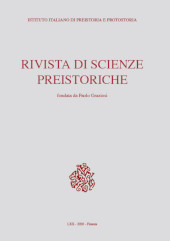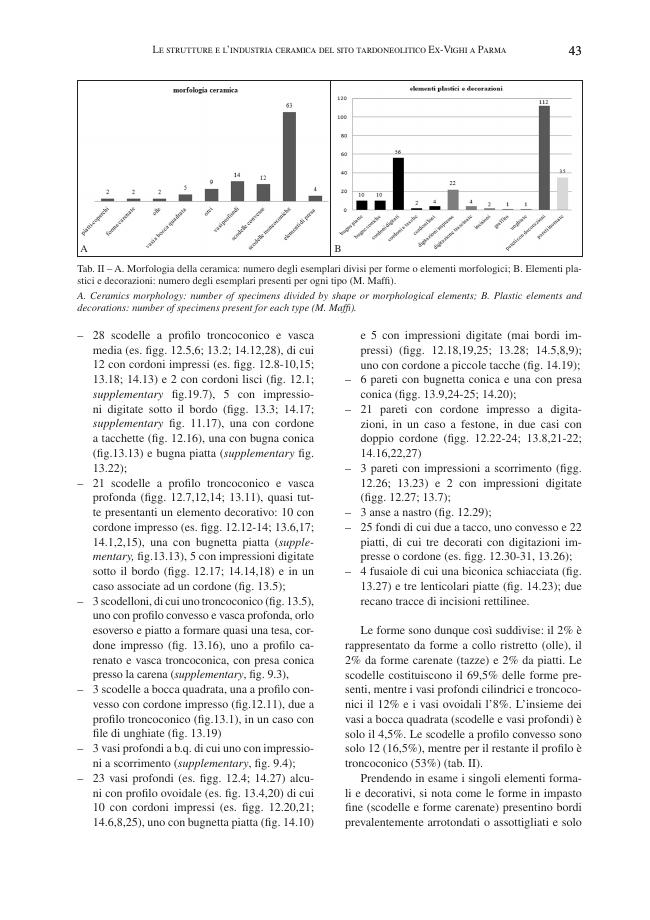Le strutture e l'industria ceramica del sito tardoneolitico Ex-Vighi a Parma
P. 29-56
The site was discovered in 2011 while building an underground car park at the site of the former Vighi medical centre, along Viale della Vittoria in Parma. The excavation brought to light a thick stratigraphy formed by a sequence of alluvial sediments bearing soils on the top from different eras. Some of these soils have returned Neolithic evidences. Of particular interest is the US 34 soil, due to the presence of both structures and pottery which, thanks also to two radiocarbon datings (4765±40 BP; 4745±35 BP), can be traced back to the middle of the 4th millennium BC cal. Several stumps confirm that the settlement was accompanied by a deforestation of the area. The structures consist of 7 hearths, 4 ovens in cylindrical pits, a series of pole holes that seem to line housing structures and numerous large, shallow pits of uncertain significance.
The ceramics appear rather homogeneous and repetitive in their types and technological traits, being characterized, with few exceptions, by coarse mixtures with abundant mineral components, mostly simple, open shapes and frequent plastic or impressed decorations. The latter stylistic features recall contemporary contexts from northern Tuscany, while some other elements seem to have been inherited from the immediately preceding Late Neolithic contexts in western Emilia, mainly due to contacts with the Alpine-Subalpine world. The Ex Vighi site is the most recent in a series of sites recently explored between the Trebbia and Enza valleys, staggered across a few centuries in the first half of the 4th millennium BC, in which local roots and alpine-subalpine and peninsular traditions form polymorphous ensembles that vary over time. Within this variability, the insertion of features from northern Tuscany represents a new element, which becomes more intense in the second half of the IV millennium BC.
The continuity between the second and third quarters of the fourth millennium indicates the absence of hiatuses between the Neolithic and Eneolithic period, confirming the continuity already identified in various aspects, including the biological one. [Publisher's text]
Il sito è stato scoperto nel 2011 durante la realizzazione di un parcheggio sotterraneo presso l'ex centro medico Vighi, lungo viale della Vittoria a Parma. Lo scavo ha portato in luce una potente stratigrafia formata da una sequenza di sedimenti alluvionali recanti al tetto suoli pertinenti a diverse epoche. Alcuni di questi suoli hanno restituito testimonianze neolitiche. Di particolare interesse il suolo US 34, per la presenza di strutture e materiale ceramico che, grazie anche a due datazioni al radiocarbonio (4765±40 BP; 4745±35 BP) sono riferibili alla metà del IV millennio BC cal. Diverse ceppaie segnalano che l'occupazione è stata accompagnata dal disboscamento dell'area. Le strutture consistono in 7 focolari a terra, 4 forni in pozzetti cilindrici, una serie di buche di palo che sembrano delineare strutture abitative e numerose fosse ampie e di scarsissima profondità, di incerto significato.
Le ceramiche appaiono piuttosto omogenee e ripetitive nei tipi e nei tratti tecnologici, essendo caratterizzate, con poche eccezioni, da impasti con abbondante degrassante minerale, da forme in larga prevalenza semplici e aperte e da frequenti decorazioni plastiche o impresse. Questi ultimi tratti stilistici richiamano contesti coevi della Toscana settentrionale, mentre alcuni altri elementi paiono ereditati da contesti tardoneolitici dell'Emilia occidentale immediatamente precedenti, debitori in prevalenza di apporti dal mondo alpino-subalpino. Il sito Ex Vighi infatti risulta essere il più recente di una serie di siti esplorati tra la Val Trebbia e la Val d'Enza, scaglionati in pochi secoli nella prima metà del IV millennio BC, nei quali radici locali e tradizioni alpine-subalpine e peninsulari formano insiemi polimorfi, variabili nel tempo.
Nel quadro di questa variabilità, rappresenta un elemento di novità la marcata ricezione di aspetti dalla Toscana settentrionale, che perdurerà, intensificandosi, anche nella seconda metà del IV millennio BC. La continuità tra II e III quarto del IV millennio segnala l'assenza di cesure tra Neolitico ed Eneolitico, confermando la continuità già individuata in vari aspetti, compreso quello biologico. [Testo dell'editore]
Ist Teil von
Rivista di scienze preistoriche : LXX, 2020-
Artikel aus derselben Ausgabe (einzeln erhältlich)
-
Informationen
DOI: 10.32097/1108
ISSN: 2282-457X
KEYWORDS
- Abitato, IV millennio BC cal., Strutture da fuoco, Tipologia e tecnologia ceramica, Confronti tra Emilia e Toscana settentrionale
- Settlement, 4th millennium BC cal., Fire structures, Ceramic type and technology, Comparisons between Emilia and northern Tuscany



